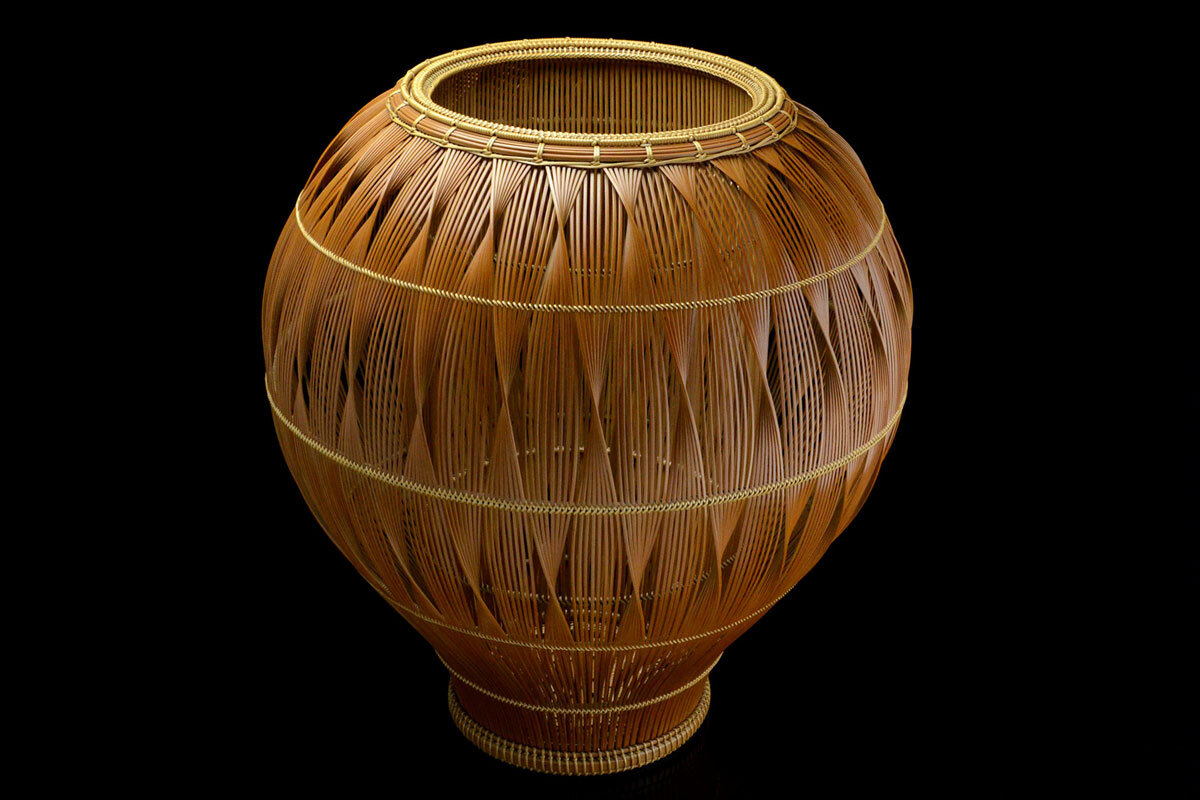BASKETRY
1976 KOSUGE KOGETSU NIHON DENTO KOGEITEN EXHIBITION FLOWER BASKET
Flower arranging basket in a tulip-like form flaring from a narrow foot-ring and returning to a wide-mouth rim. Woven of split, honey-toned bamboo and yellow rattan. Signed on the reverse by the artist with an incised signature: Kogetsu Saku or Made by Kogetsu (Kosuge Kogetsu, born 1932). Showa 51 or 1976.
With the tomobako or original box, inscribed on the interior of the lid: Sarashi-take Hineri-gumi Hana Kago or Sarashi Bamboo, Twisting Style Flower Basket; then dated: Showa Goju Ichi-nen, Ku-gatsu or Showa (era) Fifty First Year, in September; and signed: Kogetsu Saku or Made by Kogetsu, and sealed twice.
This basket was woven for exhibition at the Nihon Dento Kogei-ten or Japan Traditional Craft Exhibition in 1976 and is illustrated in the catalogue of the exhibition.
Born in Nagaoka in Niigata Prefecture, Kosuge Kogetsu apprenticed from the age of 18 under his father, Kosuge Chikudo. In 1956, he received the MITI Prize at the 2nd Nihon Kaki-Chaki Bijutsu Kogei-ten exhibition. In 1967, he was granted Nyusen acceptance at the Nitten. His first solo exhibition occurred in 1968. In 1973, was given Nyusen acceptance at the Nihon Dento Kogei-ten. Kogetsu became famous for his twisting bamboo (hineri-gumi) technique.
For another basket by the artist, c.f. Melissa Rinne’s Masters of Bamboo: Artistic Lineages in the Lloyd Cotsen Japanese Basket Collection, number 35.
Kogetsu employs a vertical, parallel construction, with arrays of eight stays alternately flat or twisting together in hineri-gumi technique. These variations occur both horizontally and vertically across the curving sides of the basket. Holding the vertical stays in place run two horizontal lines of simple wrapping (bo-maki), both slanting to the left. These frame in a central chevron of insect wrapping (mushi-maki) at the waist, while another runs just above the foot.
The basket rests on an elaborate foot ring. On the exterior a wider, beveled band of bamboo is flanked by two smaller bands. Vertical simple wrapping holds the upper two, while a lower line of diagonal simple wrapping slants to the right. On the interior, a beaded line of simple wrapping frames a wide horizontal band of bamboo, itself bound with repeating vertical lines of simple wrapping.
A variation on chrysanthemum plaiting (kiku zoko ami) formed with arrays of five stays radiates on the base.
At the rim a line of insect wrapping (mushi-maki) binds the interior edge. Beyond it runs a beaded line of simple wrapping, divided into discrete sections by cross knots (juji-musubi). Below a cord of narrow stays encircles the rim, anchored by repeating double strands of simple wrapping.
The interior of the basket is double woven, so from above one sees another cylinder of parallel construction falling to the base plaiting.
Musical in its repetitions and variations, this flower basket plays with twisting fans of movement as arrays turn, dancing across the surface.
With the original tsutsu or water container for flowers, made from a cylinder of timber bamboo with its satin surface stripped away and stained a rich red-brown.
1976 Kosuge Kogetsu Nihon Dento Kogeiten Exhibition Flower Basket
Artist Name: Kosuge Kogetsu
Period: Showa Post War
Mediums: Bamboo
Form: Basket
Origin Country: Japan
37.5 cm high x 33.5 cm diameter
14.8” high x 13.2” diameter
This piece is no longer available.





